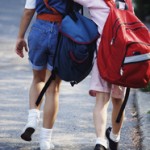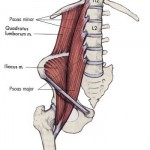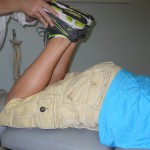Stop Backpack Injury
It’s Time to Ease the Burden for Our Children
By Dr Cynthia Horner
As a family and pediatric chiropractor I have been adjusting children in my office for 15 years. In the last few years I am seeing children and teens with serious spinal conditions from carrying heavy loads resulting in backpack injury. Parents had been bringing their kids to me for wellness spinal analysis having their spines checked before problems were bad enough for pain or symptoms to be present. Now many young people are complaining to their parents about pain in their legs, back, and shoulders and constant achy muscles.
Only approximately 5% of the children had ever experienced back or neck pain – until now
Unfortunately I am seeing children as young as 8 years old with damage to their spines due to carrying their backpacks.
I am not sure what can be done to replace the need for backpacks, but I can make known the unfortunate damage I see to these young spines. Strained muscles are painful but they do heal with rest. Unlike strained muscles damaged discs and structural changes (functional scoliosis) are difficult to correct and cause children to miss out on play activities and sports that are such an important part of growing up. If not detected and corrected early on these problems will continue into their adult life.
Common complaints I hear from children:
- Neck spasms
- Tingling hands
- Headaches
- Shoulder pain
- Low back pain
- Weakness and numbness in their legs
Shoulder and neck backpack injury:
Shoulders were not designed to carry weight. A golf bag, women’s handbag or a backpack carried on the shoulders puts strain on the joint on top of the shoulder made up of the collarbone and a piece of the scapula (wing bone on the upper back). To protect this joint from the downward strain the trapezious muscle that starts on the skull and attaches at the shoulder contracts. This constant contraction is the cause of headaches, shoulder pain, and neck pain.
Low back spinal injury from backpacks
Have you ever notice your child wearing his/her backpack low over his/her buttocks? A heavy load must be balanced or the body will literally fall over. A load consistently pulling the body backward causes an unnatural strain particularly on two postural muscles positioned on each side of the body. These muscles called the psoas muscles are located in the front of the spine from about the area of the navel extending down to attach on the inner thigh. The job of these muscles is to bend the torso forward. If a heavy load is pulling
the body back, they will respond to balance the body by contracting to keep the body from falling backward. Unfortunately these muscles attach to low back discs as well as low back vertebrae. The result of the constant strain on these muscles is damaged disc, muscle imbalances and problems in the development of the spine as the body tries to compensate and recruit other muscle to help the overtaxed psoas.
Easy way to check for backpack spinal injury
Parents can be taught how to assess their children’s psoas muscles to determine the extent of strain, and how to check their children for postural deviations that are early signs of spinal problems.
1) Ask your back pack carrying student to lie on the floor face up. Lift one of their legs up and slightly out, ask them to hold it there against gravity. Then ask them to hold it up and out as you push it down and in. They should be able to hold their leg against your pushing. Test the other leg the same way. A weak or short psoas muscle will not be able to hold against your push.
2) Now, with your student lying face down grasp his/her ankles and flex his/her legs bringing the heels close to the buttocks. Note whether their buttock or hips rise up off the floor. This is not easy to do on a bed, a floor gives a more accurate finding. If the hips rise off the floor, their psoas muscle is short and tight.
Put their back pack on a bathroom scale and weight it. If it weighs more than 10%of your students body weight it is hurting their spine. Most students are carrying 30 – 40 % of their weight, which can result in a backpack injury. No matter how properly the backpack is carried young spines and shoulders can not handle more than 10% of their body weight without injury.
What my patients have taught me “Motivation is what gets them started, habit is what keeps them going”


